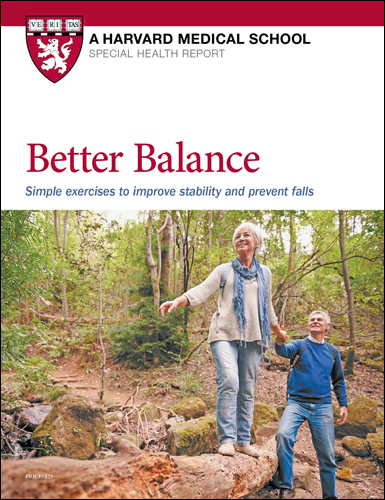Finding balance: 3 simple exercises to steady your steps
- Reviewed by Howard E. LeWine, MD, Chief Medical Editor, Harvard Health Publishing; Editorial Advisory Board Member, Harvard Health Publishing

A healthy life requires balance — and not just in a metaphorical sense. Being able to maintain physical balance is crucial to performing everyday activities from going up and down the stairs to reaching for an item on a shelf at the supermarket. But while many people squeeze in a daily walk and may even do some strength training exercises a few times a week, exercises to build balance don't always make the workout list. They should, according to experts.
As you get older, the physical systems inside your body that help you maintain your balance aren't as responsive as they were when you were younger. Maintaining balance is actually a complex task for your body, requiring coordinated action from not only your muscles, but also your eyes, ears, tendons, bones, and brain.
In addition, health problems that become more common with age, such as inner ear disorders, decreased sensation in feet, or postural hypotension (low blood pressure with standing) may leave you feeling unsteady.
Practicing exercises designed to improve your balance can help keep you upright and prevent a fall that causes injuries.
Building balance three ways
You may wonder, what exactly is a balance exercise?
Standing on one foot? Yes, that qualifies. It falls into a category called static balance exercises. These improve your balance when you're standing still. But a good balance workout should also include dynamic exercises, which are aimed at building balance when you are moving. Ideally, you should try to incorporate a few of these exercises two or three times a week.
Below are three simple exercises that you can get use to get started. The first is a static balance exercise and the other two are dynamic balance exercises. For additional ideas, read this blog post on the BEEP program.
Tandem standing

Reps: 1
Sets: 1 to 3
Intensity: Light to moderate
Hold: 5 to 30 seconds
Starting position: Stand up straight, feet hip-width apart and weight distributed evenly on both feet. Put your arms at your sides and brace your abdominal muscles.
Movement: Place your left foot directly in front of your right foot, heel to toe, and squeeze your inner thighs together. Lift your arms out to your sides at shoulder level to help you balance. Hold. Return to the starting position, then repeat with your right foot in front. This completes one rep.
Tips and techniques:
- Pick a spot straight ahead of you to focus on.
- Tighten your abdominal muscles, buttocks, and inner thighs to assist with balance.
- Keep your shoulders down and back.
Make it easier: Hold on to the back of a chair or counter with one hand.
Make it harder: Hold the position for 60 seconds; close your eyes.
Braiding



Reps: 10 to each side
Sets: 1 to 3
Intensity: Light to moderate
Tempo: Slow and controlled
Starting position: Stand up straight, feet together and weight evenly distributed on both feet. Put your arms at your sides.
Movement: Step toward the right with your right foot. Cross in front with your left foot, step out again with the right foot, and cross behind with your left foot. Continue this braiding for 10 steps to the right, then bring your feet together. Hold until steady. Now do 10 steps of braiding to the left side of the room. This completes one set.
Tips and techniques:
- Maintain neutral posture throughout.
- Look ahead of you instead of down at your feet.
- Don't turn your feet out.
Make it easier: Take smaller steps.
Make it harder: Pick up your pace while staying in control of the movement.
Rock step

Reps: 10 on each side
Sets: 1 to 3
Intensity: Moderate to high
Tempo: 2–2–2–2
Starting position: Stand up straight, feet together and weight evenly distributed on both feet. Lift your arms out to each side.
Movement: Step forward with your left foot and lift up your right knee. Hold. Step back with your right foot and lift up your left knee. This completes one rep. Finish all reps with the left foot leading, then repeat by leading with the right foot. This completes one set.
Tips and techniques:
- Tighten the buttock of the standing leg for stability.
- Maintain good posture throughout.
- Breathe comfortably.
Make it easier: Hold on to the back of a chair with one hand for support; lift your knee less.
Make it harder: Hold each knee up for a count of four.
Exercise photos by Michael Carroll
Adapted from a Harvard Health Blog post by Kelly Bilodeau.
About the Author

Harvard Health Publishing Staff
About the Reviewer

Howard E. LeWine, MD, Chief Medical Editor, Harvard Health Publishing; Editorial Advisory Board Member, Harvard Health Publishing
Disclaimer:
As a service to our readers, Harvard Health Publishing provides access to our library of archived content. Please note the date of last review or update on all articles.
No content on this site, regardless of date, should ever be used as a substitute for direct medical advice from your doctor or other qualified clinician.
















